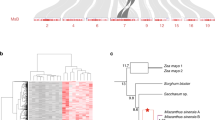Abstract
IN his revision of the British species of Agrostis, Philipson1 subdivided Agrostis canina into the two varieties A. canina var. fascicularis and A. canina var. arida. These two varieties differ from one another in several morphological features, which are mainly of a quantitative nature; but the basis of separation in Philipson's key is the presence of stolons in var. fascicularis and of rhizomes in var. arida. These varieties can be separated also by their ecological preferences. Var. fascicularis is commonly found on wet acid soils, and var. arida on the drier acid soils. Both varieties may, however, occur together.
This is a preview of subscription content, access via your institution
Access options
Subscribe to this journal
Receive 51 print issues and online access
$199.00 per year
only $3.90 per issue
Buy this article
- Purchase on Springer Link
- Instant access to full article PDF
Prices may be subject to local taxes which are calculated during checkout
Similar content being viewed by others
References
Philipson, W. R., J. Linn. Soc. Lond. Bot., 51, 73 (1937).
Sokolovskaya, A. P., J. Bot. de l'URSS., 22, 478 (1937); Cytologia, 8, 452 (1938).
Wulff, H. D., Ber. d. deut. Bot. Ges., 55, 262 (1937).
Björkman, S. O., Hereditas, 37, 465 (1951).
Myers, W. M., J. Hered., 35, 17 (1944).
Author information
Authors and Affiliations
Rights and permissions
About this article
Cite this article
JONES, K. Autotetraploidy in Agrostis canina. Nature 169, 159–160 (1952). https://doi.org/10.1038/169159b0
Issue Date:
DOI: https://doi.org/10.1038/169159b0
This article is cited by
-
Cytology and genetics of forage grasses
The Botanical Review (1961)
Comments
By submitting a comment you agree to abide by our Terms and Community Guidelines. If you find something abusive or that does not comply with our terms or guidelines please flag it as inappropriate.



